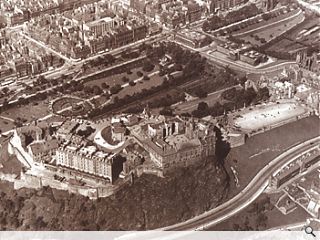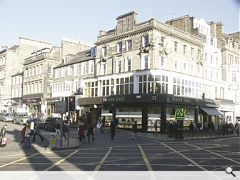Princes Street
17 Dec 2004
After years of lobbying, Malcolm Fraser’s campaign for the creative, selective demolition and redevelopment of Princes Street won official support. Then another architect offered to develop the idea for free.
The essence of this wonderful street is the rational layout of the New Town, product of the Scottish Enlightenment, set against the naturally planned, ragged and romantic Old Town, crowned by the Castle on its volcanic plug. These two ways of building cities are set against each other across the green heart of Edinburgh – Princes Street Gardens – such a fine thing to live in a city centred on a calm green space alive with the conversation between ideas built in stone.
Princes Street is at its worst when its strict rational plan has tried for order in the buildings that grow out of it. There are decent Georgian remains but a whole street of them must have been dull; a long row of plainness that was consciously revived for the daft 1960s “Princes Street Panel” buildings, a “vision” to replace all the historic buildings on the street with uniform modern drab, and an unrealisable pedestrian deck.
Princes Street is at its best when it shows off above ground. Jenners and a few others are vigorous commercial palazzos, but most of the rest are poor, unworthy of their setting, and the world’s greatest – potentially – shopping street, one rational-sided, facing heart-stopping romanticism, has too many tatty wee shops with unused floors piled above them and the depths of their sites dead.
Somebody, for Edinburgh’s sake, needed to take hold of Princes Street. To its credit e.d.i. – the City Council’s “arm’s-length” developer – did, in 1999. But they looked at the Street and its listed (overlisted) buildings and fought shy of confronting Edinburgh’s powerful conservation lobby and, in so doing, chose the wrong option. They proposed a “shopping centre” under Princes Street itself and along and under the edge of the gardens – the whole a return to the feeble 1980s idea that the only way to make a building in a historic setting is by hiding it.
There was a Public Inquiry, and I joined the team opposing the “Princes Street Galleries”. Others of my team set out why a shopping centre wouldn’t work underground, there. My contribution was to propose that, with the greatest retail context in the world, and a street that all agreed was shabby, with many empty upper floors, the future lay above ground, not below it.
I exhibited to the Inquiry drawings my office had prepared showing how two or three Princes Street properties pooled could create the potential for hugely improved shops, on occasion with a mall stretching back into the block under (and over, in glass bridges) the service lanes of James Craig’s original plan, through to the pedestrianised Rose Street with its smaller-scale shopping. These larger, united plots would create modern, more accessible retail properties. Some could multiply their few high-rental pavement metres by up to six, by wrapping them into their shared sites to develop upper retail floors round the malls, a bit like Princes Square in Glasgow. Co-operation between Princes Street’s institutional owners would, in this way, be levered through convenient capitalism. This development potential – and urban vigour – would be augmented by flats and offices above the shops and malls with staggering views (for shoppers, out the end of a glazed mall) across to the castle and Old Town.
The underground “galleries” proposal survived the Inquiry but not unscathed, and now is no more.
I’m an optimist so expected, post-Inquiry, Edinburgh’s many city agencies to come chapping at my door. Not so. So I, with civic amenity group the Cockburn Association – representing the conservation lobby – and a retail surveyor – to represent the development lobby – took the plan forward. We did the ownership searches, architectural assessment and data assembling, delineation of 10 development sites and plans, sections and perspectives of four of them, together with quantifying and totalling areas, development potential and overall figures and timescales.
We presented exhaustively to the retailers and business interests – successfully too. To everybody, though, we argued that a confident commercial redevelopment must be matched by, first, confident repair of the remaining good buildings from the past and, secondly, that if modern architecture were to replace old architecture it must be of the very best quality, worthy of its setting, place and time.
On that basis we presented to all the many overlapping pieces of the Heritage Lobby. They, bless their often-maligned souls, understood what we were saying and were agreeable to a substantial set of unofficially loseable buildings being lost. The ability to unlock sites by removing, or substantially reducing, the “listed building risk” was hugely valuable, a significant barrier overcome.
Finally we presented exhaustively to the myriad city agencies until, after four years of our unpaid initiative, the council leader, Donald Anderson, personally endorsed our Framework Plan and one of the city’s agencies, ECC, paid us a modest amount (a pittance, for all that work, but gratefully received). Donald launched the Plan but no city agency was able, or prepared, to put any sort of push behind it – to develop individual proposals to show the institutional investors. Concerned that time and opportunity were draining away, we presented again, over 18 months, to the city’s three lead agencies, setting out in detail what needed to be done to move forward. Given our knowledge and initiative, we hoped for an instruction or, at least, consultation on how the next stage would be tackled to ensure all aims of the Framework would be realised.
We heard nothing until calls from the press telling me that, following an approach from city authorities, a big, national, London-based commercial practice with an office in Edinburgh was taking the Plan forward. My concern is that city authorities should remember that what we presented and what people, including the Heritage Lobby, bought into was demolition and development, but with the parallel repair of good, existing fabric and only if the architecture was of the very best. But development people tend to switch off after they hear the word “development” – themselves name checked – so the other essential components go over their heads.
As an example of what the “parallel repair of good, existing fabric” might be I have presented, on numerous occasions, to city development authorities and city heritage authorities a proposal for the Georgian group of buildings on the east corner of Princes and Hanover Streets. Here upper floors lie empty because of problems with access and escape. But, as with the institutional owners of Princes Street’s main commercial property, a co-operative Feasibility Study would give them the economic leverage to sort out the problems together, repair their buildings and sell bright Georgian apartments in the classical heart of a booming city. None has had the gumption to commission such work and, for whatever reason, the complementary heritage repair is not, at this moment, happening.
As for great modern architecture, they are not going about this the right way either. As I understand it, the firm now working on the Plan was approached direct and is doing the work for free. And I’m told that the plans have been developed so that, instead of using James Craig’s lanes to bring light and definition of retail space, and drama, and architecture into development, some, at least, are proposed to be erased. So I worry that these people are thinking that they can get away with retail space that is not simple and subtle, but big and dumb, with a bit of architecture glued to its façade. A significant amount of Edinburgh’s New Town was spoilt in the 70s and 80s by large commercial architecture firms building straw-coloured brick office boxes with glued on (retained, or pastiched) Georgian fronts and I fear that we’re going to repeat this mistake on Princes Street, with “quality materials with a modern twist” frontages glued on to big, retail boxes. I think that Edinburgh people deserve better and want buildings that will lift our hearts.
I am no great fan of the superstar architects, though I could live with the odd one. But there are many good moderns whose work I’d love to see on Princes Street – as there are many Edinburgh architects who could and should build here, but are generally ignored at the elite city level. Such bold modern architecture would present my chums in the heritage lobby with their next big challenge – to, when there’s a “gap” in the street, relax, be open and supportive, and appreciate something fresh and startling.
Princes Street is the most high-profile economic and cultural drag on Edinburgh, and the city should not rely on favours to secure its health. It needs proper investment from city authorities, a necessary financial commitment to the heart of Edinburgh and an open process to attract and engage architects of care and flair to move us forward.
by Malcolm Fraser
Read next: Porth Wen Brickworks, Anglesey
Read previous: Ask yourself not what your website can do for you, but what you can do for your website.
Back to December 2004
Browse Features Archive
Search
News
For more news from the industry visit our News section.
Features & Reports
For more information from the industry visit our Features & Reports section.




